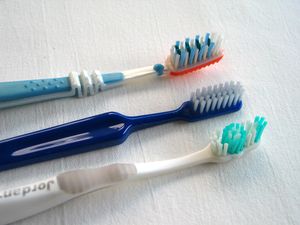Toothbrush

The toothbrush is an oral hygiene instrument used to clean the teeth and gums that consists of a head of tightly clustered bristles mounted on a handle, which facilitates the cleansing of hard-to-reach areas of the mouth. Toothpaste, which often contains fluoride, is commonly used in conjunction with a toothbrush to increase the effectiveness of toothbrushing. Toothbrushes are available with different bristle textures, sizes and forms. Most dentists recommend using a toothbrush labelled "soft", since firmer bristled toothbrushes can damage tooth enamel and irritate the gums.[1] Toothbrushes have usually been made from synthetic fibers since they were developed, although animal bristles are still sometimes used.
Contents |
History
A variety of oral hygiene measures have been used since before recorded history. This has been verified by various excavations done all over the world, in which chewsticks, tree twigs, bird feathers, animal bones and porcupine quills were recovered. The first toothbrush recorded in history was made in 3000 B.C., a twig with a frayed end called a chewstick.
Many peoples have used some form of toothbrushes through the ages. Indian medicine (Ayurveda) has used the twigs of the neem or banyan tree to make toothbrushes and other oral-hygiene-related products for millennia. The end of a neem twig is chewed until it is soft and splayed, and it is then used to brush the teeth. In the Muslim world chewing miswak, or siwak, the roots or twigs of the Arak tree (Salvadora persica), which have antiseptic properties, is common practice. The usage of miswak dates back at least to the time of the Prophet Mohamed, who pioneered its use. Rubbing baking soda or chalk against the teeth has also been common practice in history.
Japanese Zen master Dōgen Kigen recorded on Shōbōgenzō that he saw monks clean their teeth with a brush in China in 1223 with brushes made of horse-tail hairs attached to an ox-bone handle.

The earliest identified use of the word toothbrush in English was in the autobiography of Anthony Wood, who wrote in 1690 that he had bought a toothbrush off J. Barret.[2]
William Addis of England is believed to have produced the first mass-produced toothbrush in 1780.[3][4] In 1770 he had been jailed for causing a riot; while in prison he decided that the method used to clean teeth – at the time rubbing a rag with soot and salt on the teeth – could be improved, so he took a small animal bone, drilled small holes in it, obtained some bristles from a guard, tied them in tufts, passed the tufts through the holes on the bone, and glued them. He soon became very wealthy. He died in 1808, and left the business to his eldest son, also called William; the company continues to this day[5]. By 1840 toothbrushes were being mass-produced in England, France, Germany, and Japan[5]. Pig bristle was used for cheaper toothbrushes, and badger hair for the more expensive ones[5].
The first patent for a toothbrush was by H. N. Wadsworth in 1857 (US Patent No. 18,653) in the United States, but mass production in the USA only started in 1885. The rather advanced design had a bone handle with holes bored into it for the Siberian boar hair bristles. Animal bristle was not an ideal material as it retains bacteria and does not dry well, and the bristles often fell out. In the USA brushing teeth did not become routine until after World War II, when American soldiers had to clean their teeth daily.[3]

Natural animal bristles were replaced by synthetic fibers, usually nylon, by DuPont in 1938. The first nylon bristle toothbrush, made with nylon yarn, went on sale on February 24, 1938. The first electric toothbrush, the Broxodent, was invented in Switzerland in 1954.
In January 2003 the toothbrush was selected as the number one invention Americans could not live without according to the Lemelson-MIT Invention Index.[6]
Environmental impact
While each brush is a small source of pollution, toothbrushes make up 50 million pounds of plastics discarded in landfill per year in the USA alone.[7][8]
See also
- Oral hygiene
- Teeth cleaning twig
- Dental floss
- Toothpaste
- Chewable toothbrush
- Electric toothbrush
- Ultrasonic cleaning
- Miswak
References
- ↑ "Oral Longevity," American Dental Association brochure (PDF), page 2 Retrieved June 12, 2008
- ↑ Olmert, Michael (1996). Milton's Teeth and Ovid's Umbrella: Curiouser & Curiouser Adventures in History, p.62. Simon & Schuster, New York. ISBN 0684801647.
- ↑ 3.0 3.1 History of Dentistry and Dental Care
- ↑ "Who invented the toothbrush and when was it invented?". The Library of Congress. 2007-04-04. http://www.loc.gov/rr/scitech/mysteries/tooth.html. Retrieved 2008-04-12.
- ↑ 5.0 5.1 5.2 The company founded by Addis in 1780
- ↑ "2003 Invention Index". 2003-01-21. http://web.mit.edu/invent/n-pressreleases/n-press-03index.html. Retrieved 2009-05-20.
- ↑ Amount of tooth brushes wasted per year
- ↑ Amount of toothbrushes per year for USA
External links
- Taking Care of Your Teeth Naturally
- American Dental Association statements on Toothbrushing
- International Toothbrush Collection, a searchable database
- BBC h2g2 The History of Toothpaste and Toothbrushes
|
|||||||||||||||||||||||||||||||||||||||||